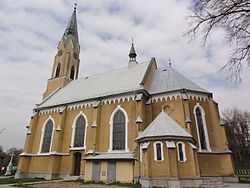Mazańcowice
| Mazańcowice | ||
|---|---|---|
| Village | ||

Saint Mary Magdalene Church
|
||
|
||
| Coordinates: 49°51′25.4″N 18°58′45.6″E / 49.857056°N 18.979333°E | ||
| Country | Poland | |
| Voivodeship | Silesian | |
| County | Bielsko | |
| Gmina | Jasienica | |
| First mentioned | 1305 | |
| Government | ||
| • Mayor | Zdzisław Florek | |
| Area | 8.18 km2 (3.16 sq mi) | |
| Population (2009) | 3,401 | |
| • Density | 420/km2 (1,100/sq mi) | |
| Time zone | CET (UTC+1) | |
| • Summer (DST) | CEST (UTC+2) | |
| Postal code | 43-391 | |
| Car plates | SBI | |
Mazańcowice [mazaɲt͡sɔˈvit͡sɛ] (German: Matzdorf) is a village in Gmina Jasienica, Bielsko County, Silesian Voivodeship, southern Poland. It has a population of 3,401 (2009) and lies in the historical region of Cieszyn Silesia.
The name of the village is derived from personal name Mazaniec (Mazanek). The name was first recorded (1305) with a typical Slavic ending -itcz (-ice), then it was also mentioned with a typical German ending -dorf (Mazanczendorff, 1452 and Matzdorff in 1566).
The village was first mentioned in a Latin document of Diocese of Wrocław called Liber fundationis episcopatus Vratislaviensis from around 1305 as item in Mansanczovitcz. It meant that the village was in the process of location (the size of land to pay a tithe from was not yet precised). The creation of the village was a part of a larger settlement campaign taking place in the late 13th century on the territory of what will be later known as Upper Silesia.
Politically the village belonged initially to the Duchy of Teschen, formed in 1290 in the process of feudal fragmentation of Poland and was ruled by a local branch of Piast dynasty. In 1327 the duchy became a fee of Kingdom of Bohemia, which after 1526 became part of the Habsburg Monarchy. In 1572 it became a part of Bielsko state country, in 1754 elevated to Duchy of Bielsko.
...
Wikipedia


